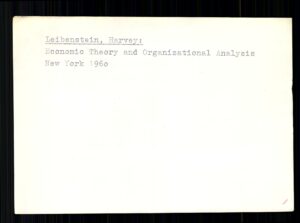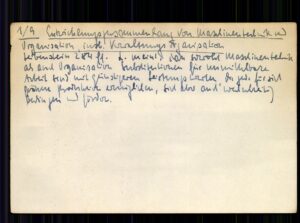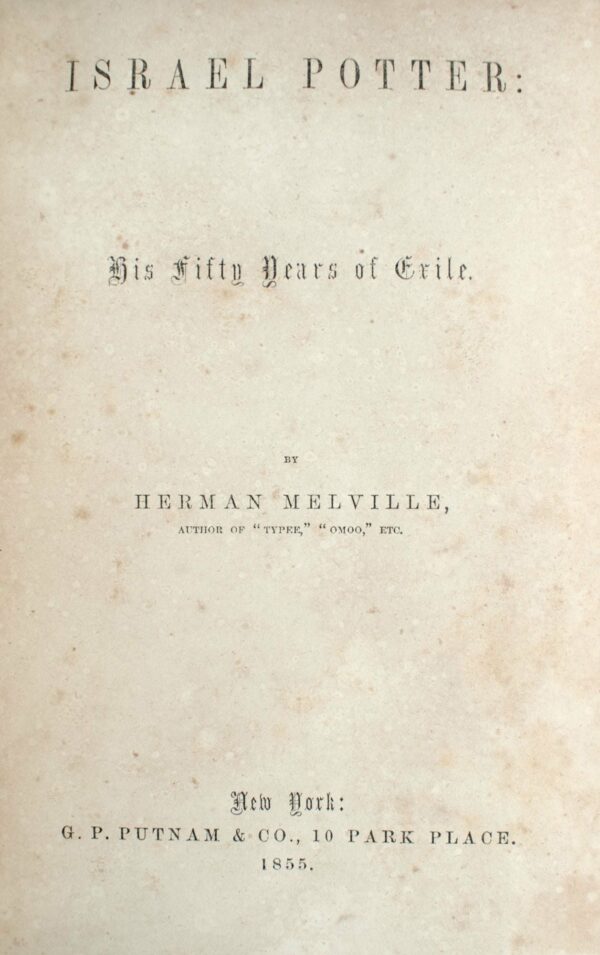Nun stellte u.a. Alfred Weber eine Analogie von Verwaltung und Apparat auf, brachte Max Weber jene mit der Maschine in Anschlag. (Büromaschinen und so …) Luhmann suchte all dies zu endigen und neuen Begrifflichkeiten der Organisationssoziologie den Weg zu bereiten. (Vgl. zu all dem Maschine 1963 ff.!)
Liest man nun dazu in Luhmann Funktionen und Folgen formaler Organisation (1964) genauer nach, wird klar, dass seine wesentliche Berufungsgrundlage Harvey Leibensteins Economic Theory and Organizational Analysis (1960) ist. Da eine Tagung im Oktober 2024 – Welcome to the Machine! – diese Analogien und Tropen mit in die Ziehung zu nehmen bestrebt gewesen sein wird (ganz abgesehen vom Thema der Kanzlei- und Büroordnungen, der Amtsinstructionen etc.), soll ho. einschlägiges Material die Komplexität verdichten helfen.
Mit oberflächlichen Analogien zwischen Chefzimmern und heiligen Orten, Organisation und Maschine, Autorität und Befehl oder den Pedanterien der Aktenführung und den Ritualien des Fruchtbarkeitszaubers ist es freilich nicht getan. Äquivalenzen lassen sich überzeugend und begründbar nur aufdecken, wenn die Bezugsprobleme hinreichend abstrahiert und klar verstanden sind. Das Recht zu malerischen und konkreten Ausarbeitungen muß auf einem langen Umweg durch eine hochabstrahierte Theorie sozialer Handlungssysteme verdient werden.
Niklas Luhmann: Funktionen und Folgen formaler Organisation. Berlin: Duncker & Humblot 1964, S. 20.
Robert Michels und Max Weber explizieren das Problem der Bürokratie in Begriffen von Herrschaft und Gehorsam und von Zweck und Mittel zugleich, ohne deren Verhältnis zu klären. In der neueren Organisationstheorie tritt dass Dilemma auf beiden Seiten deutlich zutage: Einerseits werden die Grenzen der Zweckorientierung, und zwar sowohl die faktischen wie die rationalen Grenzen, gesehen. Es ist weder möglich noch sinnvoll, alles Handeln in organisierten Systemen aus dem Organisationszweck abzuleiten. Neben der Zweckorientierung wird eine Orientierung auch an anderen Gesichtspunkten, zum Beispiel dem des Systembestandes, gefordert. [/] Andererseits befriedigt auch die Definition von Herrschaft nicht, weil man – ganz abgesehen von den autoritätskritischen Tendenzen der modernen Betriebssoziologie – der Divergenz von formaler Autorität und faktischer Macht und der Tatsache nichtlegitimierbarer Erwartungen des Vorgesetzten Rechnung tragen muß.
Niklas Luhmann: Funktionen und Folgen formaler Organisation. Berlin: Duncker & Humblot 1964, S. 33f.
Wenn diese Bedenken ernst genommen werden, müssen die beiden Prototypen der älteren Organisationslehre, die sich wechselseitig gefordert und stimuliert haben: Die Maschine als rationale Zweckkonstruktion [25] und der Befehl, ihren Rang als Leitvorstellungen der Organisation verlieren [26]. Dadurch erst, daß Zweckorientierung und Befehl als definierende Bezugsbegriffe der Theorie aufgegeben werden, können sie Themen einer funktionalen und empirischen Forschung werden.
Diese Kritik läuft auf den Gedanken hinaus, den wir schon in der Einleitung vorangestellt haben: Die Definition der formalen Organisation durch Zweck und (oder) Herrschaft ist darauf abgestellt, Organisationen „als in sich schlüssige rationale Konstruktionen zu erforschen mit dem Ziele, Unrichtigkeiten und Fehlkonstruktionen auszumerzen. Sie setzt die Organisation als rational an. Die begrenzten Fähigkeiten des Menschen zu rationalem Verhalten, von seiner begrenzten Lust dazu ganz zu schweigen, erscheinen ihr deshalb als unsinniger externer Widerstand, den sie weder verstehen noch erforschen kann. Seit der Entdeckung „informaler“ Sozialordnungen innerhalb von Organisationen, die teils neben der formalen Organisation, teils für sie, teils gegen sie wirken, ist diese Auffassung überholt. Dem sollte durch einen neuen Begriff der formalen Organisation Rechnung getragen werden.
Die beiden Fußnoten 25 und 26 schlüsseln näher auf:
[25] Dabei war der Angelpunkt der Analogie von Organisation und Maschine nicht etwa die mechanische Bewegung, wie oberflächliche Kritiker meinten, sondern die Ausschließlichkeit der Zweckorientierung, die für alle Teile und jeden Vollzug der Maschine gilt.
Niklas Luhmann: Funktionen und Folgen formaler Organisation. Berlin: Duncker & Humblot 1964, S. 33.
[26] Eine Kritik des Maschinenmodells und des Befehlsmodells, die deren inneren Zusammenhang besonders berücksichtigt, findet sich bei Leibenstein 1960 S. 138 ff., 162 ff.
Hiervon – der damit als erworben erachteten Grundlage – ausgehend wird Luhmann fortsetzen, nachlegen; zumindest zwei Mal noch – wesentlich auch im Zusammenhang mit (an die elektronische Datenverarbeitung bereits sehr deutlich rührend) dem Begriff der »Unsicherheitsabsorption«! (s.u.: ✭) – zu zitieren sein:
Unsicherheitsabsorption kann in hohem Maße auch durch feste Institutionen geleistet werden, durch eine Automatik eingelebter Situationsauslegungen, die keiner Entscheidung mehr bedürfen. Das gilt bereits für die Sprache, die das System benutzt, ferner für alle institutionalisierten Situationsauslegungen und vor allem für rituelle Handlungsvorschriften, für alle Informationsverarbeitungen, die bereits vorgeleistet, mit dem sozialen System selbst erbracht sind. Durch solche gleichsam automatische Systemverantwortung wird dem einzelnen die Pflicht zur Informationsverarbeitung in hohem Maße abgenommen, sie beschränkt sich auf das Erkennen und Mitteilen von Zeichen, die eine bestimmte Situationsauslegung in Kraft setzen. Routinehandeln in diesem Sinne ist keineswegs ein Privileg formaler Organisationen.
Niklas Luhmann: Funktionen und Folgen formaler Organisation. Berlin: Duncker & Humblot 1964, S. 176.
Daneben trägt auch das latente Bewußtsein oder die volle Verdrängung ins Unterbewußte zur Unsicherheitsabsorption bei. Sie verschlucken zahlreiche Alternativen und damit zahlreiche Zweifel. Und außerdem wären die Techniken maschineller Informationsverarbeitung zu nennen, die es ermöglichen, bisher unhandliche Mengen von Informationen rationell auszuwerten. Welche Bedeutung der Verantwortung zwischen diesen funktional äquivalenten Alternativen überhaupt zukommt, wird von System zu System verschieden sein.
Schließlich erfaßt die funktionale Analyse auch die Denkmodelle, von denen man bisher ausging, um die Rationalität des Handelns in Organisationen zu verstehen:
Niklas Luhmann: Funktionen und Folgen formaler Organisation. Berlin: Duncker & Humblot 1964, S. 385.
a) Zwecke und Mittel sind nicht strukturelle Vorgegebenheiten, die man zu finden und zu erkennen hätte, sondern Symbole für die Absicht, eine Handlung funktional zu analysieren, das heißt: mit anderen Möglichkeiten zu vergleichen.
b) Diese funktionale Analyse des Handelns enthüllt, daß Mittel stets latente Folgen haben, die außerhalb des Zweckes liegen und ihm widersprächen, wollte man sie als Motiv heranziehen. Deshalb ist es nicht möglich, Organisationen in Analogie zur Maschine zu verstehen.
c) Dem Maschinenmodell der Organisation entsprach die Vorstellung einer fast reibungslosen Entscheidungsübertragung durch Befehl. Diese Auffassung wird entkräftet durch Analysen, welche die wirkliche Funktion formaler Autorität und die Funktion wirklicher Autorität außerhalb der formalen Befehlswege zum Gegenstand haben.
d) Wie bei den Einzelhandlungen und Einzelentscheidungen, So zersetzt auch bei den generalisierten Erwartungen, den normativen Regeln, die expansive Fragestellung des Funktionalismus alte Ausgangspunkte. Sich um das richtige Verständnis von Normen und um ihre Durchsetzung zu kümmern, ist gewiß nach wie vor sinnvoll; aber die Rationalität des Zusammenhanges von Normfeststellung, Subsumtion und Sanktionierung
des abweichenden Verhaltens versteht sich nicht mehr von selbst, sondern wird an Funktionen abgelesen, die auch andere Möglichkeiten in den Blick ziehen: Möglichkeiten anderer Normsetzung ebenso wie Möglichkeiten des unnormierten oder illegalen Verhaltens und des Durchgehenlassens von Verstößen.

Leibenstein. In Luhmann Zettelkasten sauber mit der Maschine hineingetippt. Insgesamt dürfte er sich drei Mal in diesem Verzeichnissystem finden. Ein zweiter Zettel sei jedenfalls erwähnt, eine Notiz Luhmanns: »1/9 Entwicklungszusammenhang von Maschinentechnik und Organisation, ins. Verwaltungsorganisation
Leibenstein 284 ff. L. meint, dass sowohl Maschinentechnik als auch Organisation Substitutionen für unmittelbare Arbeit sind […]«

Greift man nun in Leibensteins Buch, obzitierte Verweisstellen und die im Zettelkasten eingeschriebenen Belege zu finden, stößt man unschwer auf die folgenden Feststellungen:
ORGANIZATION AND THE MACHINE ANALOGY
Harvey Leibenstein: Economic Theory and Organizational Analysis. New York: Harper & Brothers 1960, S. 138f.
It is not uncommon to think of organizations as machines with human parts. While this concept may have some value, it could be quite misleading. If an organization is to be looked upon as a machine, then it must be as a unique type of machine with characteristics quite different from other mechanical devices such as watches, automobiles, engines of various sorts, and so on. Even the analogy with servo-mechanisms of the usual kind, such as a thermostat, does not go far enough. Indeed the interesting aspects of an organization are precisely those in which it differs from the ordinary machine.
Organizations, like machines, may have to be designed with a certain purpose or set of purposes in mind. Suppose, to begin with, that the organization is to perform a given job. That is, there is a given output and it could repeat the output indefinitely, period after period. (Later we consider the possibility of changes in the output of the organization.) From the point of view of the machine analogy, how should the organization be set up to produce the output?
The output implies or determines the scale of operations and the size of the organization. Specifically, we have to find a set of activities that will produce the necessary output. Simultaneously we have to determine the factors of production, that is, the combination of labor, equipment, and materials, that could carry out the requisite activities. In the usual case, where there is more than one set of factors of production that could perform the activities and more than one set of activities that will produce the output, we would pick an activity bundle and an associated factor bundle in accordance with with some criterion. For example, we usually would want to choose that factor bundle and its related activity set that would cost least. We associate its costs with each bundle of factors. Where any bundle can carry out more than one set of activities to produce the output, then we associate with that bundle the least costly set of activities. We then rank the bundles of factors in terms of their cost and pick the least costly factor bundle.
The task of organization here is purely mechanical. We have to obtain a set of activities that dovetail with each other in terms of both the sequence and the nature of the activities. In other words, for each person in the organization we set up performance specifications for the activities so that activities dovetail; at the same time we set up a sequence of activities and a spatial arrangement so that they all fit in with each other. This done, we presumably have a machine that will produce the desired output.
If we want an organizational machine that will produce variable outputs, the situation is not fundamentally different. Our task is to choose factor bundles that can carry out more than one set of activities on order. If the set of factors is chosen on the same basis as before, our machine will then produce a range of outputs. Of course, the factor sets would have to be so chosen that part of the activities possible included those minimal communication activities necessary to pass on the orders required to make the machine shift from the production of one output to the production of another.
As a matter of fact, almost no organizations of any size are of the kind just described. The employment of human parts as well as some other elements in the situation makes the strictly mechanical analogy inappropriate.
Consider some of the elements which, in fact, are not known but which are presumed to be known in the machine analogy. (1) The required output may be changing, but the nature of the output and its amount have to be discovered by the organization itself. (2) The activities to be performed may be changing and also not completely known. (3) Similarly, the capacities of the factors of production may be changing; in any event they are likely to be incompletely known. (4) Finally, the availability of factors to the firm for purposes of replacement are also incompletely known. In sum, we have to build our organization in such a way that simultaneously with performance we have the means of gathering information about the changing environment and about the possibly changing capacities and activities within the organization. […]
Harvey Leibenstein: Economic Theory and Organizational Analysis. New York: Harper & Brothers 1960, S. 140
Also, since the organization itself determines in part its specific objectives, we have to look at the organization not as the usual kind of a machine but as an entity in which the user of the »mechanism« and the »mechanism« itself are part of the same entity.
AUTHORITY, COMMUNICATION, AND ORGANIZATIONAL ACTIVITY
Harvey Leibenstein: Economic Theory and Organizational Analysis. New York: Harper & Brothers 1960, S. 162f. [Anm.: die Fußnote 3 lautet bei Leibenstein: »Keeping in mind the qualifications in the last chapter about the machine analogy.«]
Authority and communication are the life blood of the organization. Through them orders are given, decisions communicated, and actions taken. One might say that it is through authority and communication that a mass of human beings is made into an organizational machine. [3] The analogy of a machine would be especially apt where the authority and communication relations are functions —that is, where in all cases there are one-to-one correspondences between the superior’s alternatives and the subordinate’s alternatives, and between the sender’s messages and the receiver’s interpretations, and where in all cases the perceptions of the relations are identical for all parties involved.
Let us look at the machine analogy again for a moment. Sup- pose someone is trying to make a machine in which the parts are human beings. The reason he may want to do this is that human beings operating as a coordinated group may be able to accomplish more than when they work in isolation. A good machine is a set of precisely coordinated parts. When some parts are worked, other parts move and operate as a consequence. For example, in some machines, if we push certain buttons, certain wheels will be expected to turn. In the same way we can create machines using humans as parts. By imposing or creating authority and communication relationships we obtain a mechanism whereby when one in authority makes certain choices (pushes certain buttons) and communicates them, certain activities follow. If these relations are one-to-one correspondences, the activities that follow will be exactly those that are expected by the authority (the button pusher). This is, of course, similar to what we expect in a perfectly functioning inanimate machine.
However, it would be usually quite foolish to construct such an organizational machine. Given the properties of the parts involved [/] we might construct much more effective machines—machines in which the parts utilize their capacity to store and sift information, to make choices, and often to make sensitive and complicated judgments. We shall see as we proceed that if we utilize these capacities of at least some of the parts of our potential organizational machine we can, in most cases, construct much more effective machines than otherwise.
The main reason the simple mechanical machines we have described do not lead to the most effective organizational forms is that we have not taken into account such unique capacities of individuals as their capacities to store information, to gather information, to assess situations, and to make recommendations based on such assessments.
Der Boden ist bereitet, auf dem Maschinen und Verwaltung ihre Rollen spielen sollen.
What seems to have occurred over the last half-century, for which figures are available, and probably for a very much longer period for which exact data are difficult to come by, is that there has been a general substitution of machinery for labor and with it a greater need for organizational machinery per direct operative. This suggests the possibility that organization and machinery are complementary factors of production. But why should they be primarily complementary agents of production? Why should we not substitute organization for mechanical machinery just as we have substituted machinery for direct labor? One might argue perhaps that organization itself is a type of machinery and that therefore organizational machinery and mechanical machinery are substitutes one for the other depending on the relative prices of the two. Yet the trend suggests that both organization and nonhuman machinery have grown together and that both have been substituted for direct labor.
Harvey Leibenstein: Economic Theory and Organizational Analysis. New York: Harper & Brothers 1960, S. 285.
The main point is that the trend toward greater labor productivity has been achieved by increasing specialization, and that this in turn has been facilitated by increases in both nonhuman machinery and organizational machinery. [3] Now it is likely that the possibility of the duplication and repetition of relatively simple activities is what stimulates the invention of nonhuman machines to carry out such activities. Thus, the factors entering into the extension of specialization also suggest the type of machinery that can be created to substitute mechanical for human efforts. Usually the simultaneous standardization (and duplication) of the consequences of the standardized activities, namely, the commodities themselves, will be involved. After the standardization of specific activities, the standardization of whole sequences or bundles of activities may also be possible.
Harvey Leibenstein: Economic Theory and Organizational Analysis. New York: Harper & Brothers 1960, S. 286. [Anm.: die Fußnote 3 lautet bei Leibenstein: »And this includes mechanical contrivances to aid the administrative sector. In part there has been a substitution of machinery for administrative labor, but to a much lesser extent than that of machinery for direct labor.«]
Das ist es, worauf Luhmann mit der Zettelkastennotiz aus ist.
But let us return to our main problem area—the trend toward higher organizational costs. As labor productivity rises and wages rise accordingly, there is a substitution of machinery for labor. At the same time increased output may also be achieved by substituting organization for direct labor. That is to say, increased specialization which yields greater output implies simultaneously ail increased amount of organization per direct worker. Probably both the substitution of machinery for labor and the substitution of organization for labor take place simultaneously because there is no reason why a firm should not simultaneously employ both avenues to increase productivity. In addition, we have argued that a great deal of industrial machinery is of a type that facilitates specialization, and since organization both facilitates and is required by specialization, they should be complementary factors of production.
Harvey Leibenstein: Economic Theory and Organizational Analysis. New York: Harper & Brothers 1960, S. 288.
The empirical evidence indicates that large firms will have smaller administrative costs (per unit of output and per operative) on the average than small firms. Yet it is often observed that when a firm expands or plans its expansion the planned and actual increase in administrative personnel is larger proportionately than the increase in output and in operatives. How can we reconcile this paradox? It becomes clear when we see that unlike nonhuman machinery (which can be purchased) the organizational machinery has to be built, and more personnel is usually required for the building of the machine than for its maintenance. In other words, during the expansion period when additional organizational machinery has to be constructed a larger increase in nonoperative personnel is necessary. However, once the expansion is over, the increased administrative personnel has to be either absorbed by the substitution of organization for direct labor (the trend factor discussed in the previous section) or disposed of by the gradual release or lack of replacement of administrative staff upon retirements, dismissals, and resignations.
Harvey Leibenstein: Economic Theory and Organizational Analysis. New York: Harper & Brothers 1960, S. 289.
✭ Zu Unsicherheitsabsorption und Negativgarantie (Außenkoontaktstellen, Grenzstellen … wir lesen: Schnittstellen):
Auf die besondere Verantwortung von Außenkontaktstellen hatten wir […] bereits hingewiesen. Die Grenzstellen interpretieren die Umwelt für das System. Sie müssen Umweltinformationen sichten und sieben und sie in eine Sprache bringen, die im System verstanden und akzeptiert wird. Ihre Verantwortung besteht nicht nur in der Richtigkeit der Informationswiedergabe, sondern vor allem in der Negativgarantie: daß nichts weiter los ist; denn zur Unsicherheitsabsorption an den Grenzen ist es notwendig, die Informationen, die in das System hineingegeben werden, so auszuwählen, daß das System sich auf die Bearbeitung dieser spezifischen Informationen beschränken und alles andere vernachlässigen kann.
Niklas Luhmann: Funktionen und Folgen formaler Organisation. Berlin: Duncker & Humblot 1964, S. 224.


